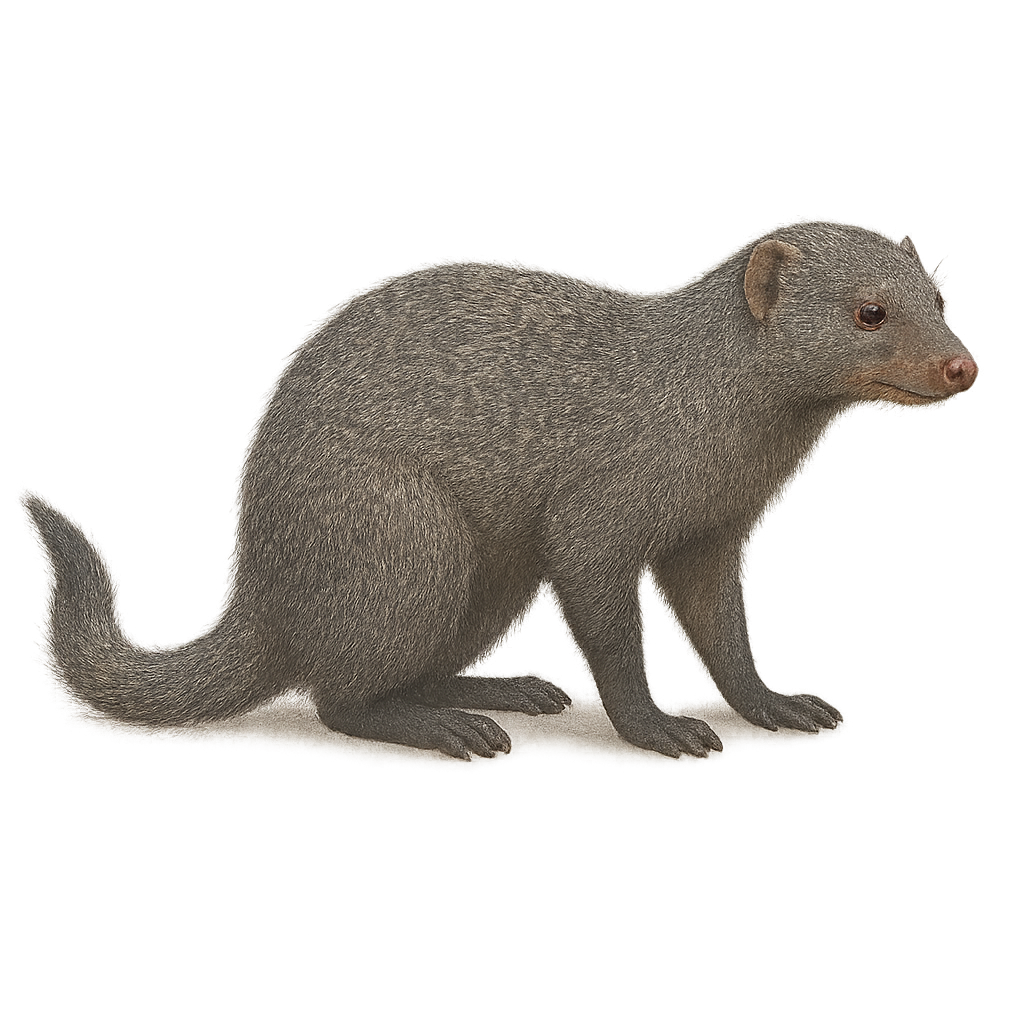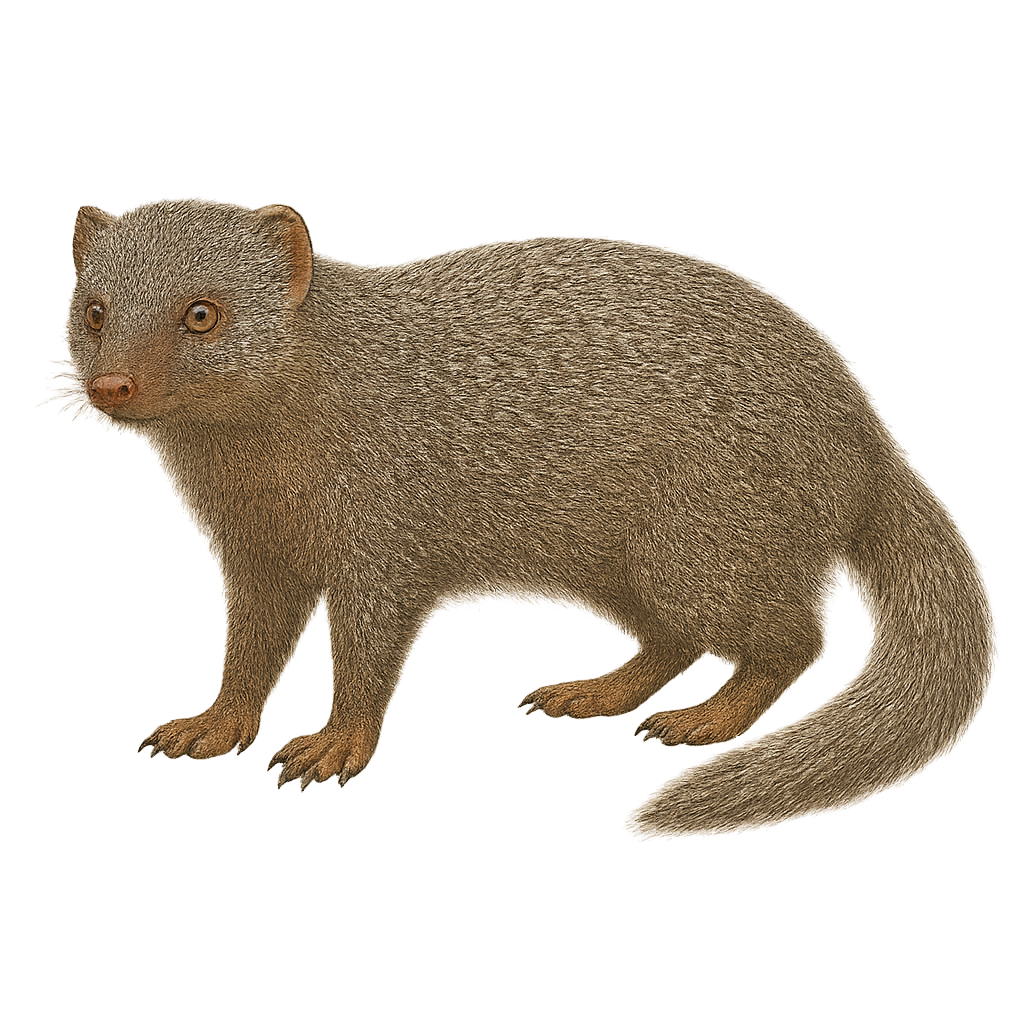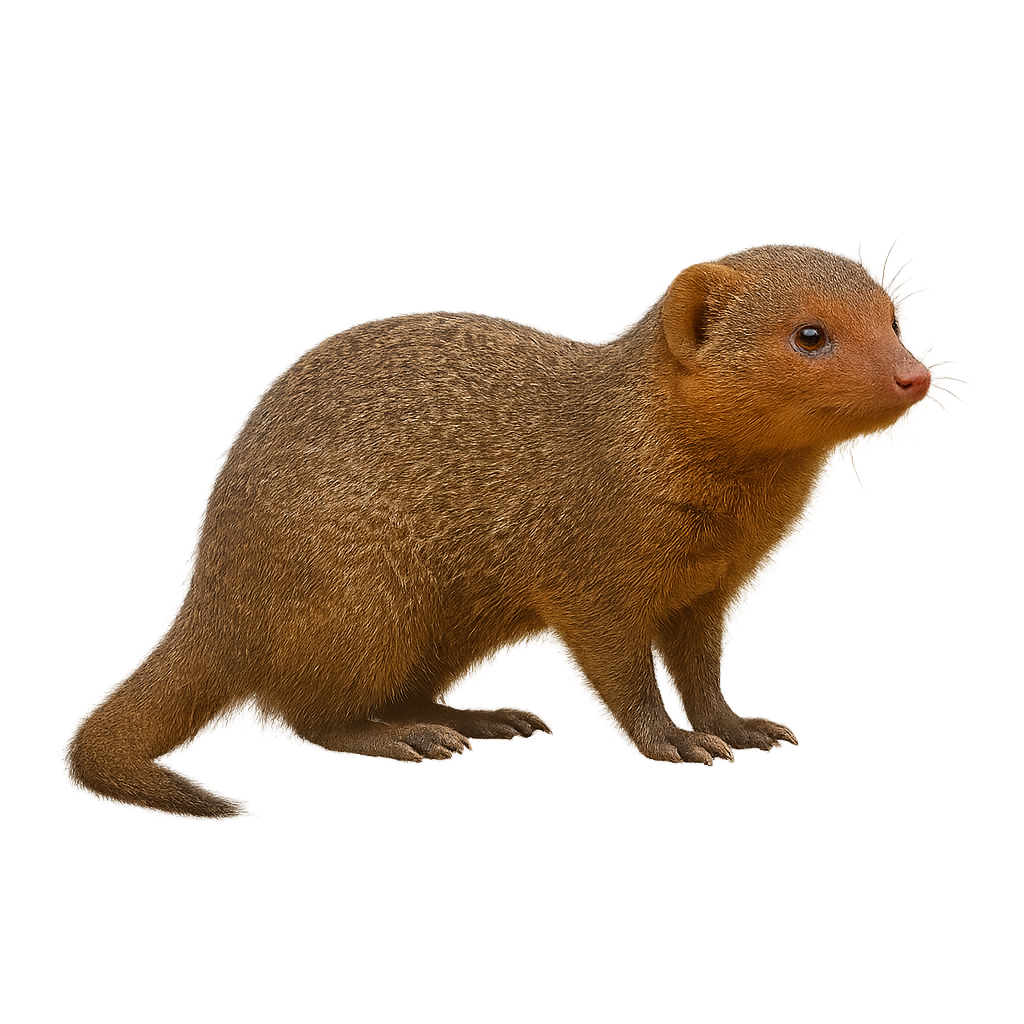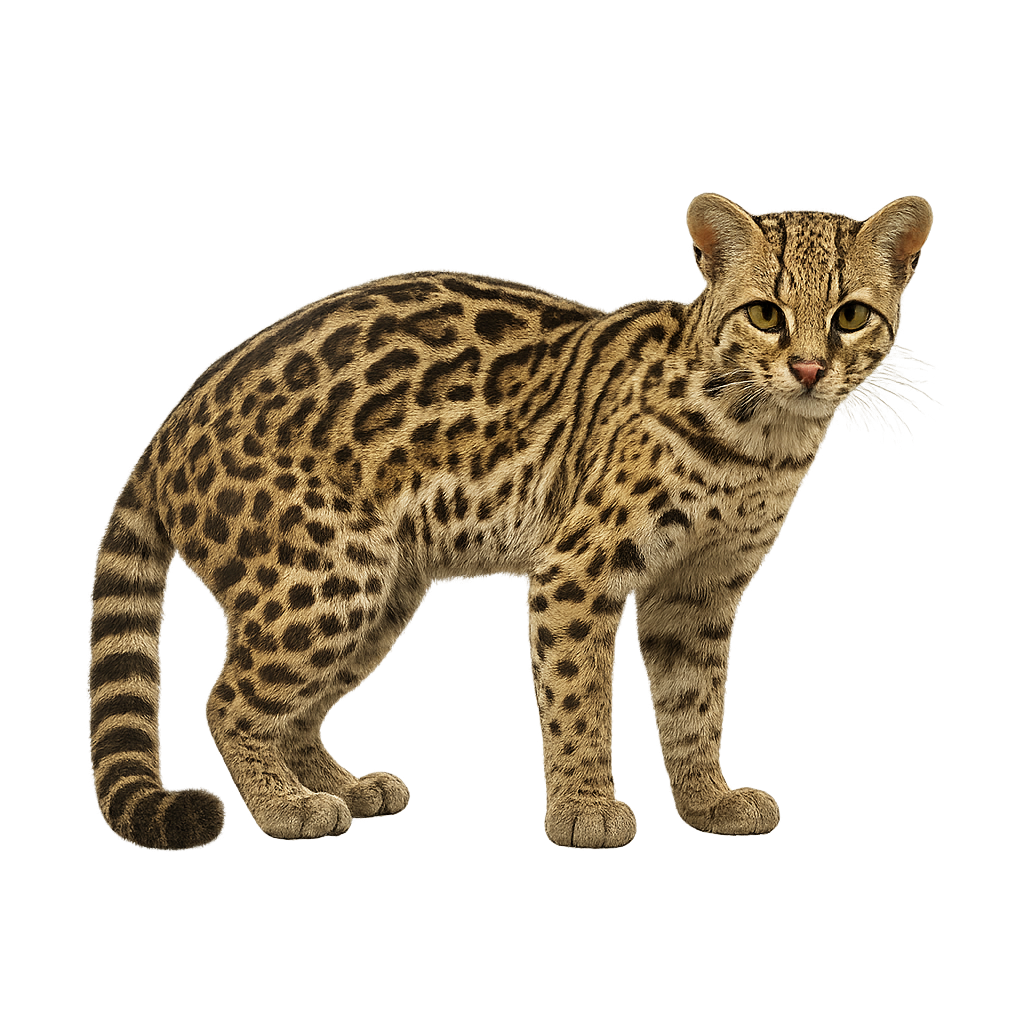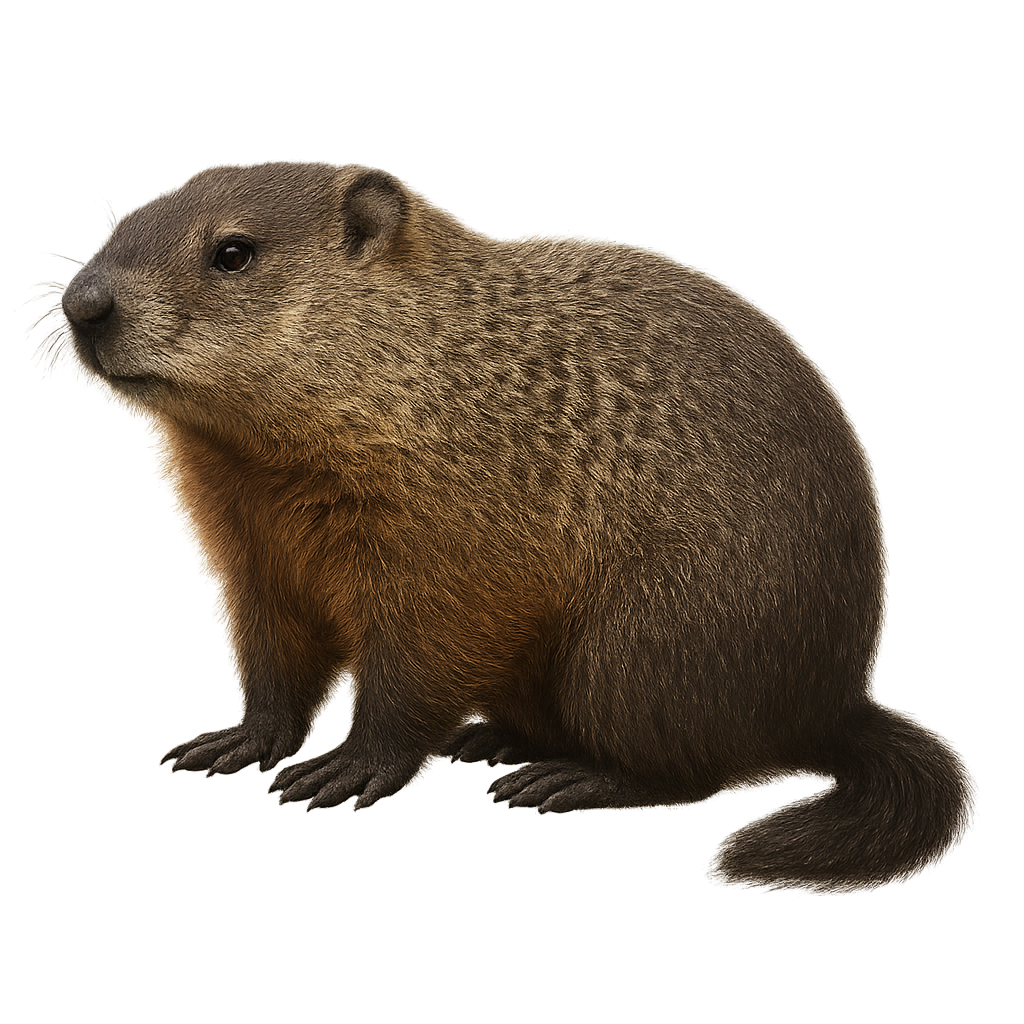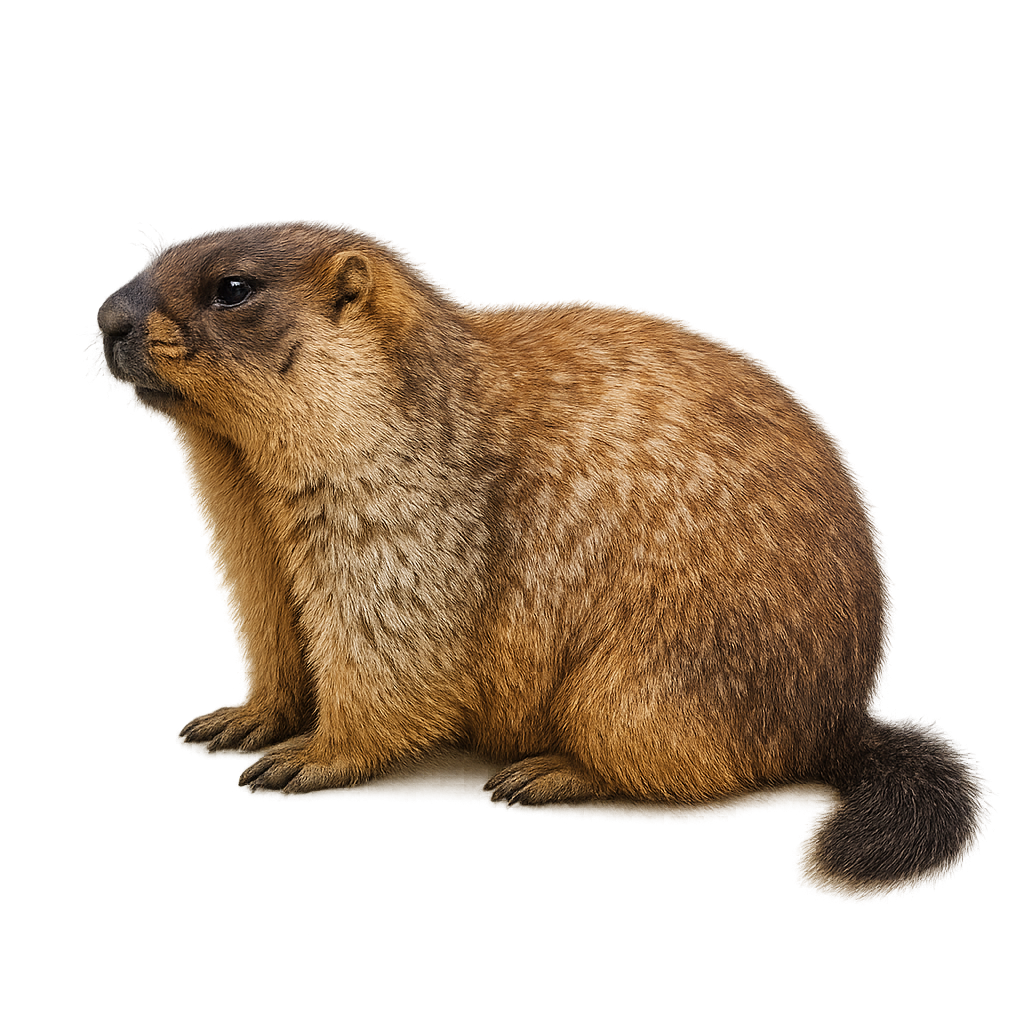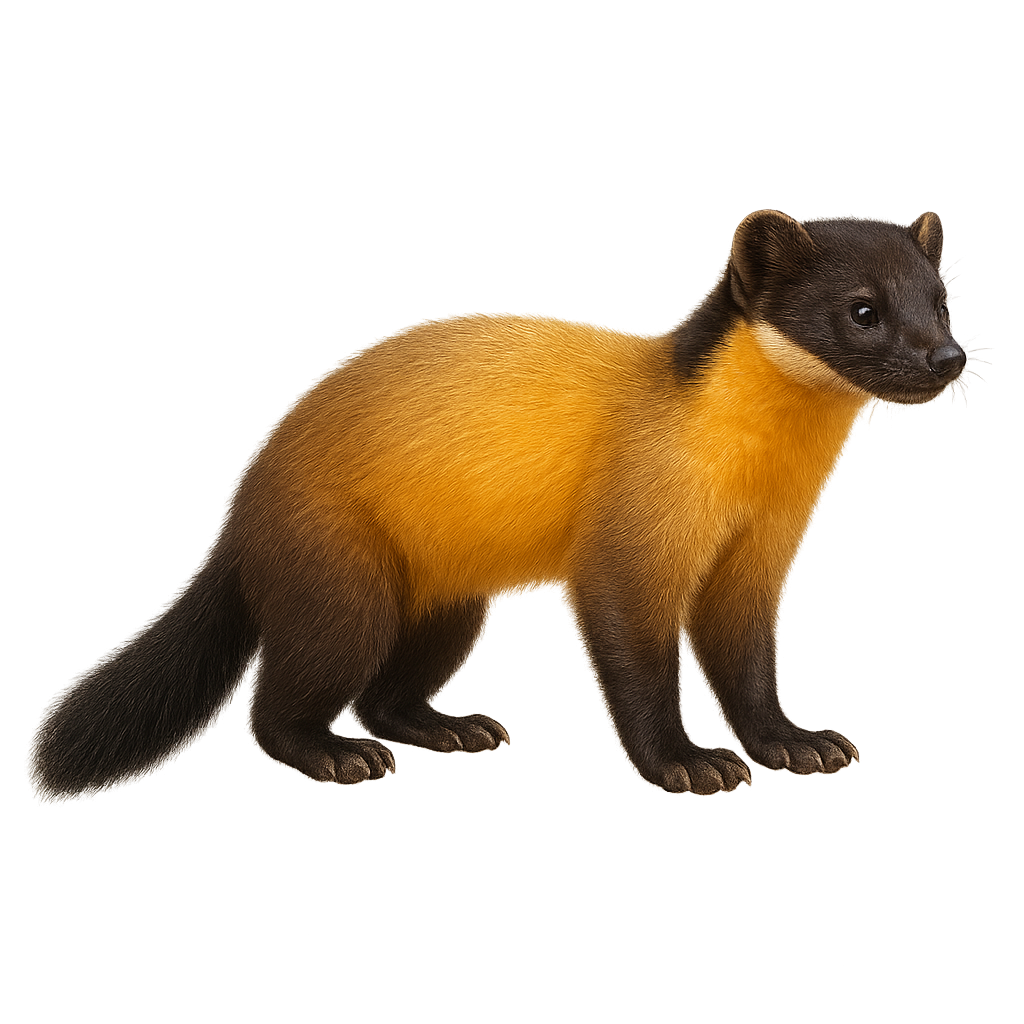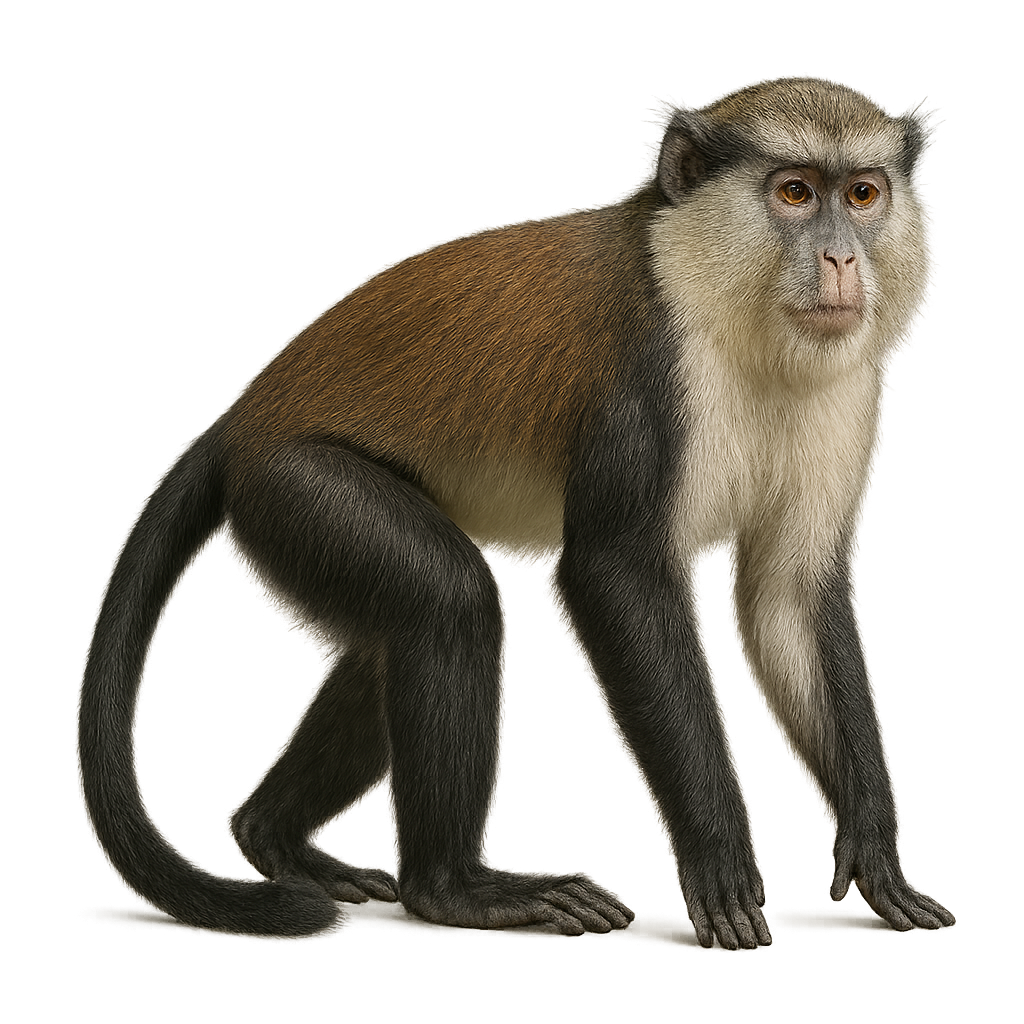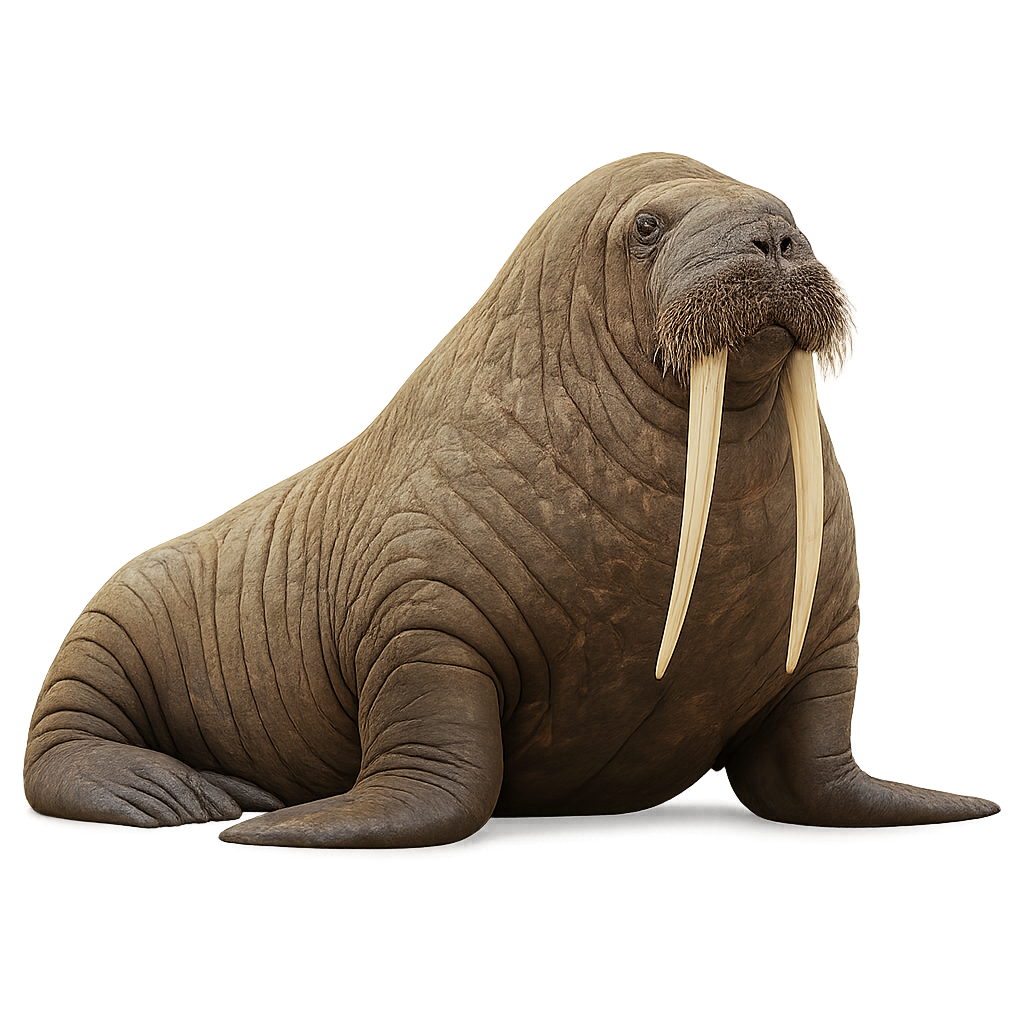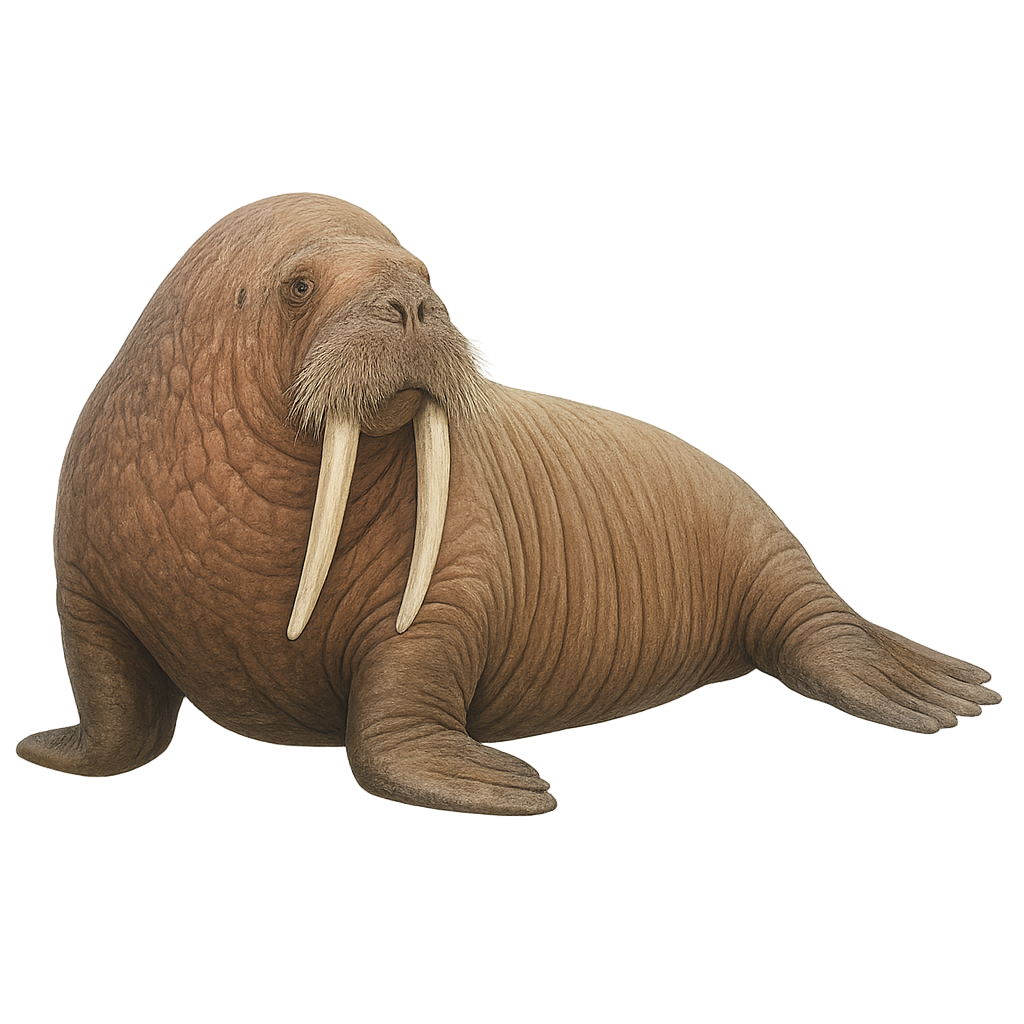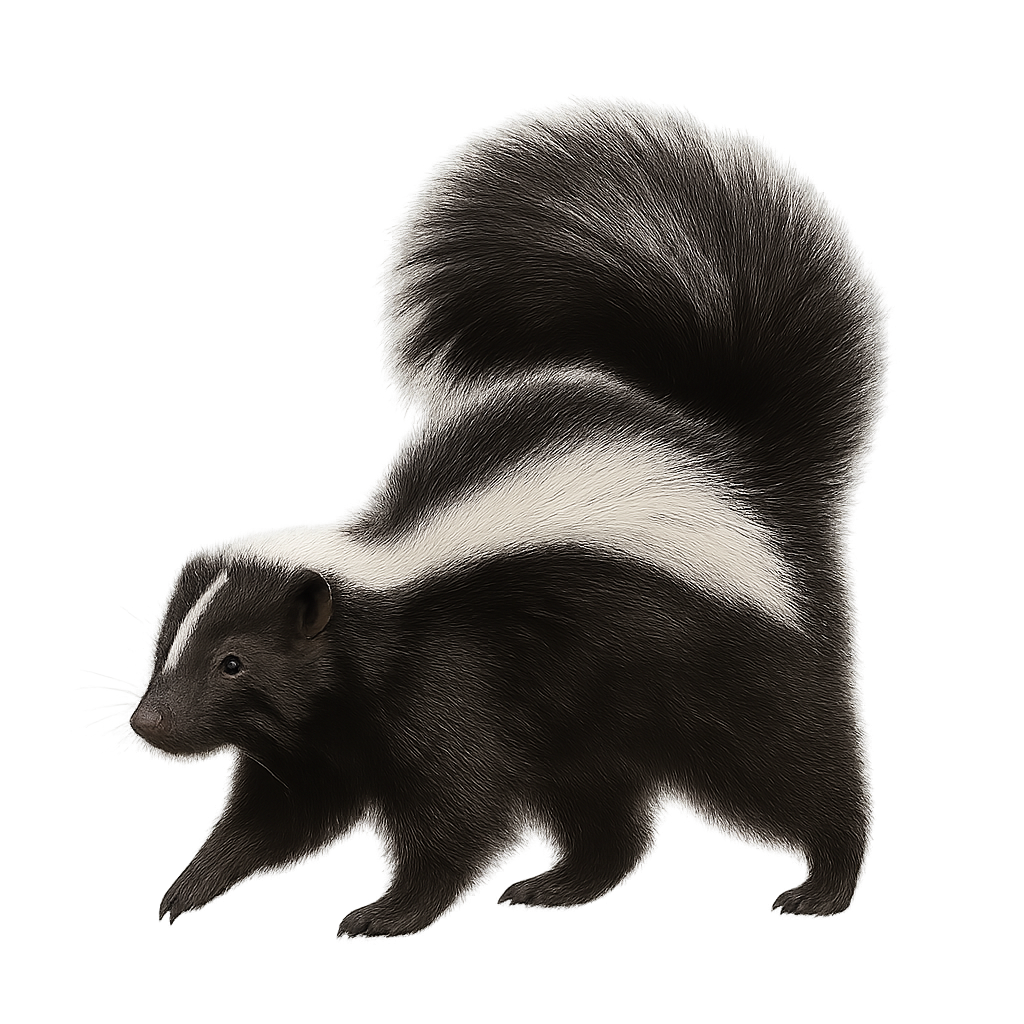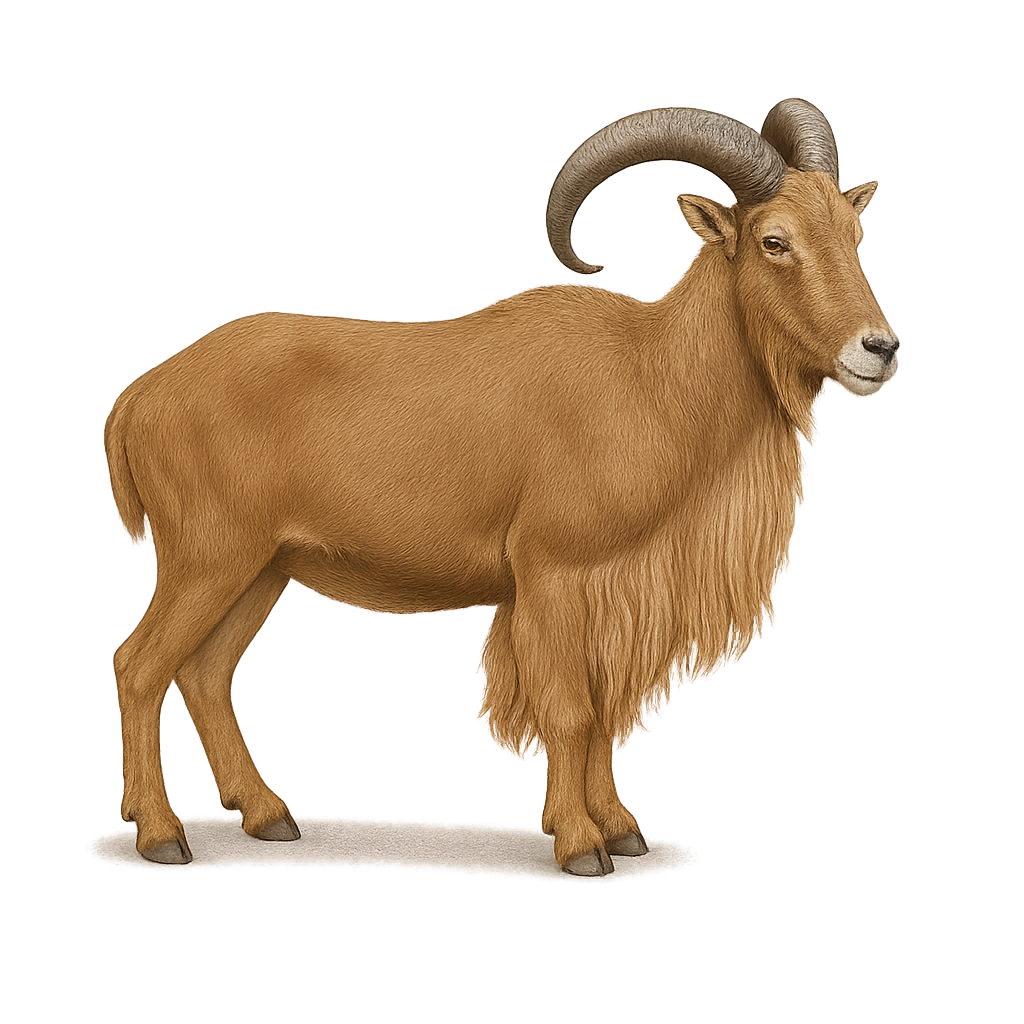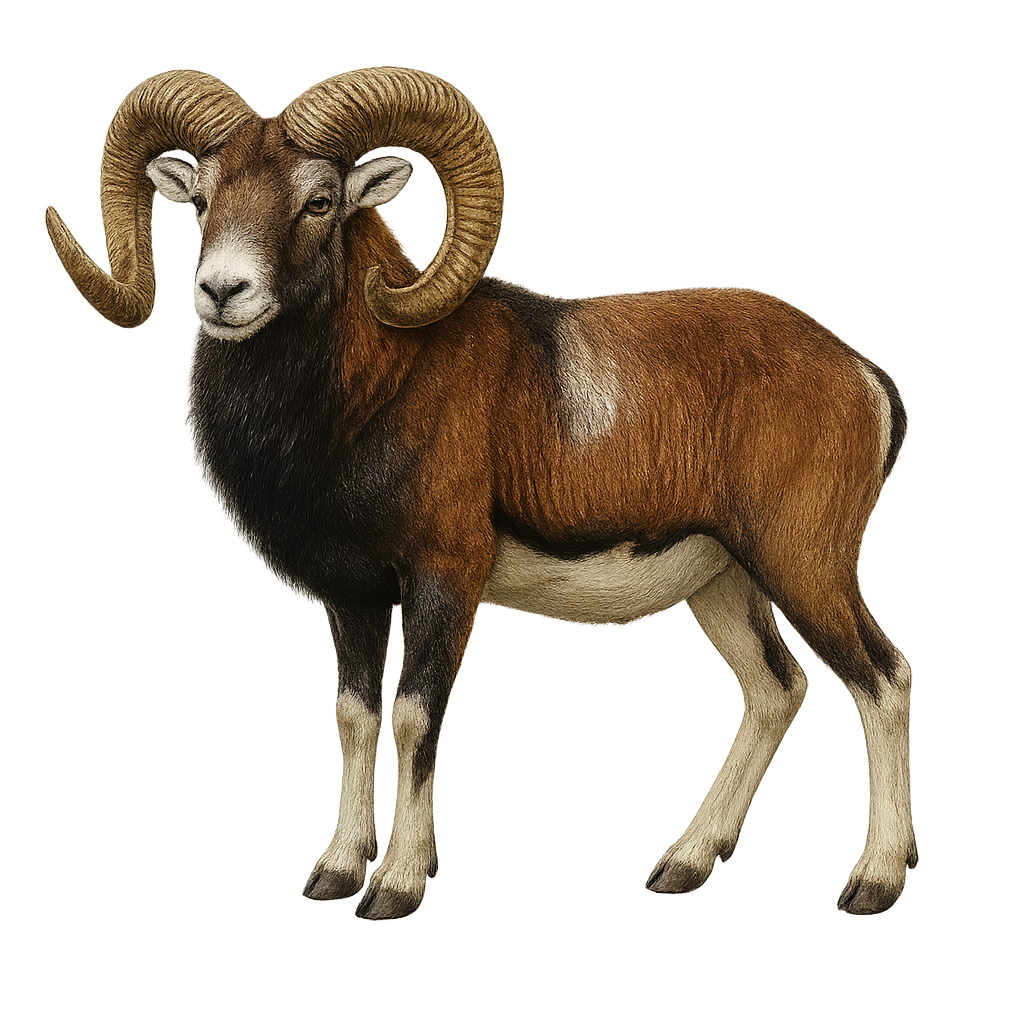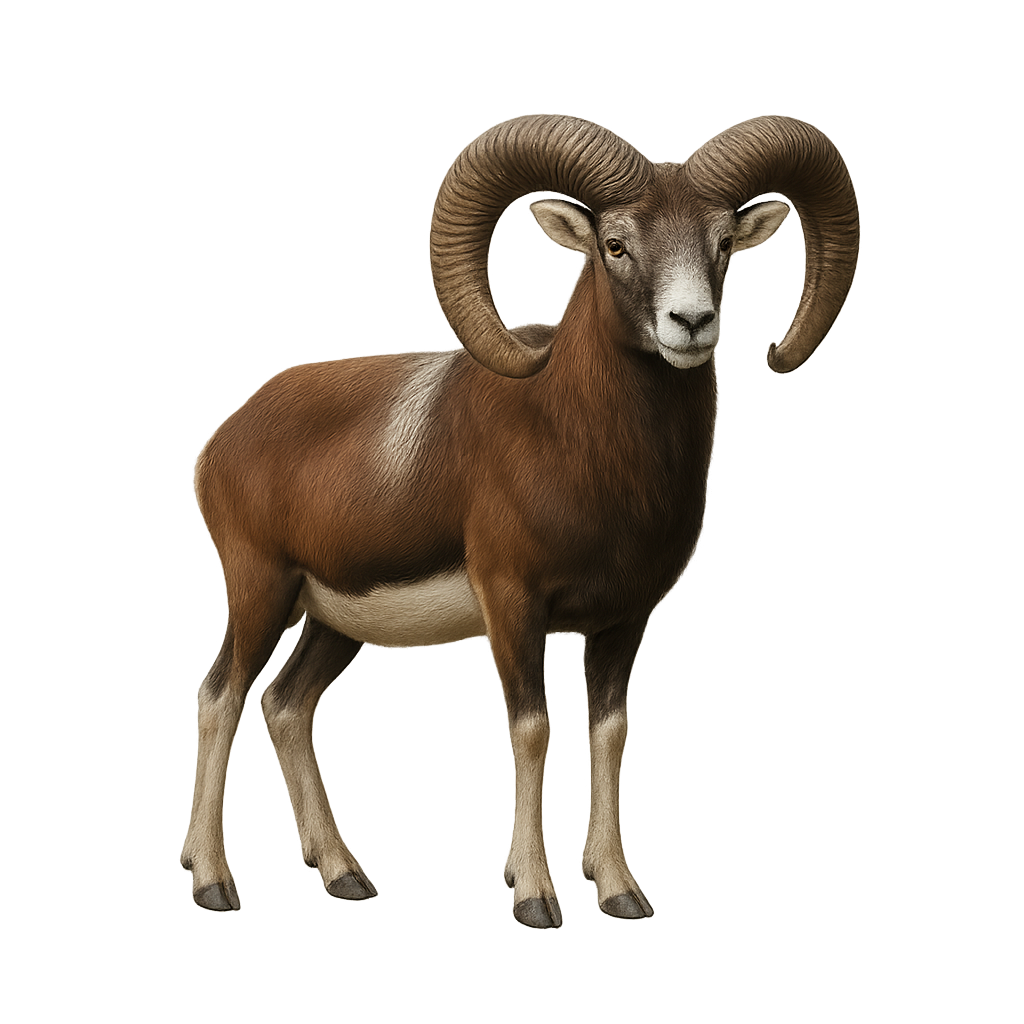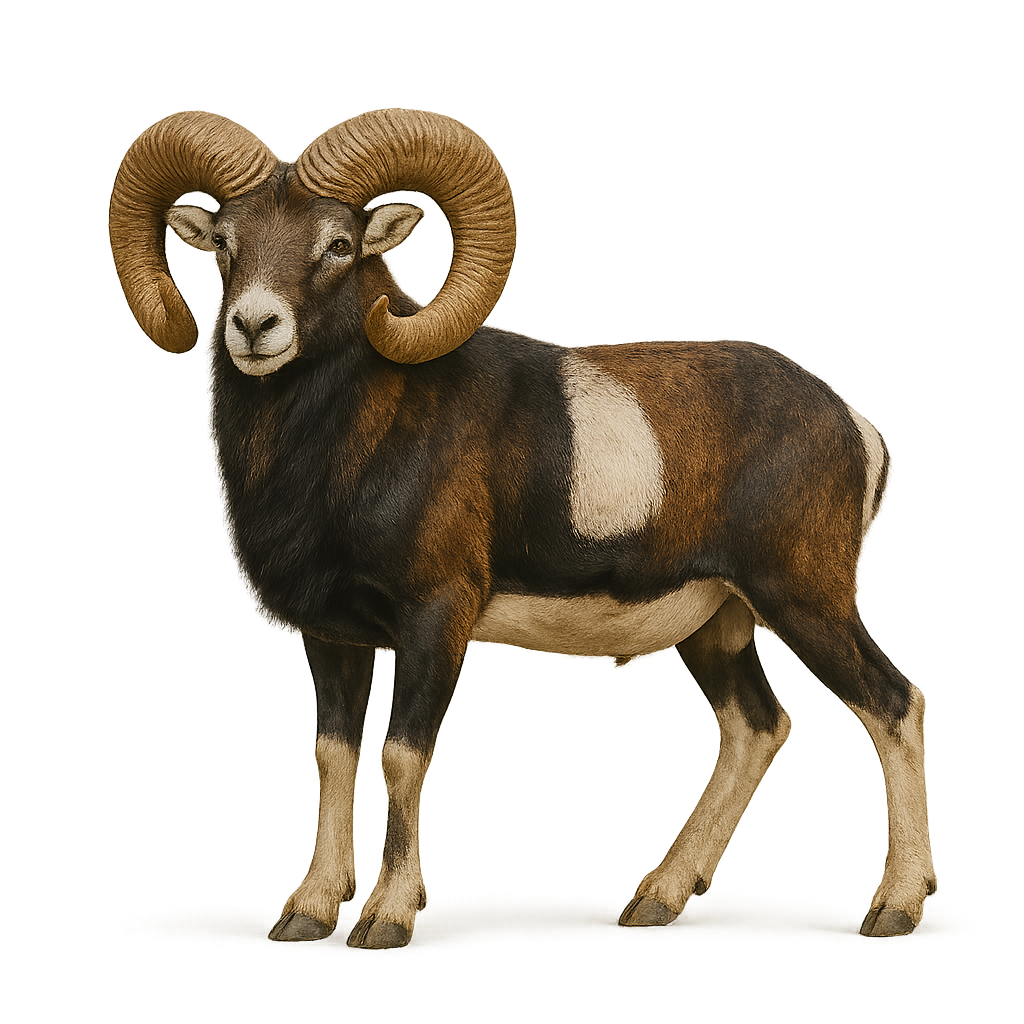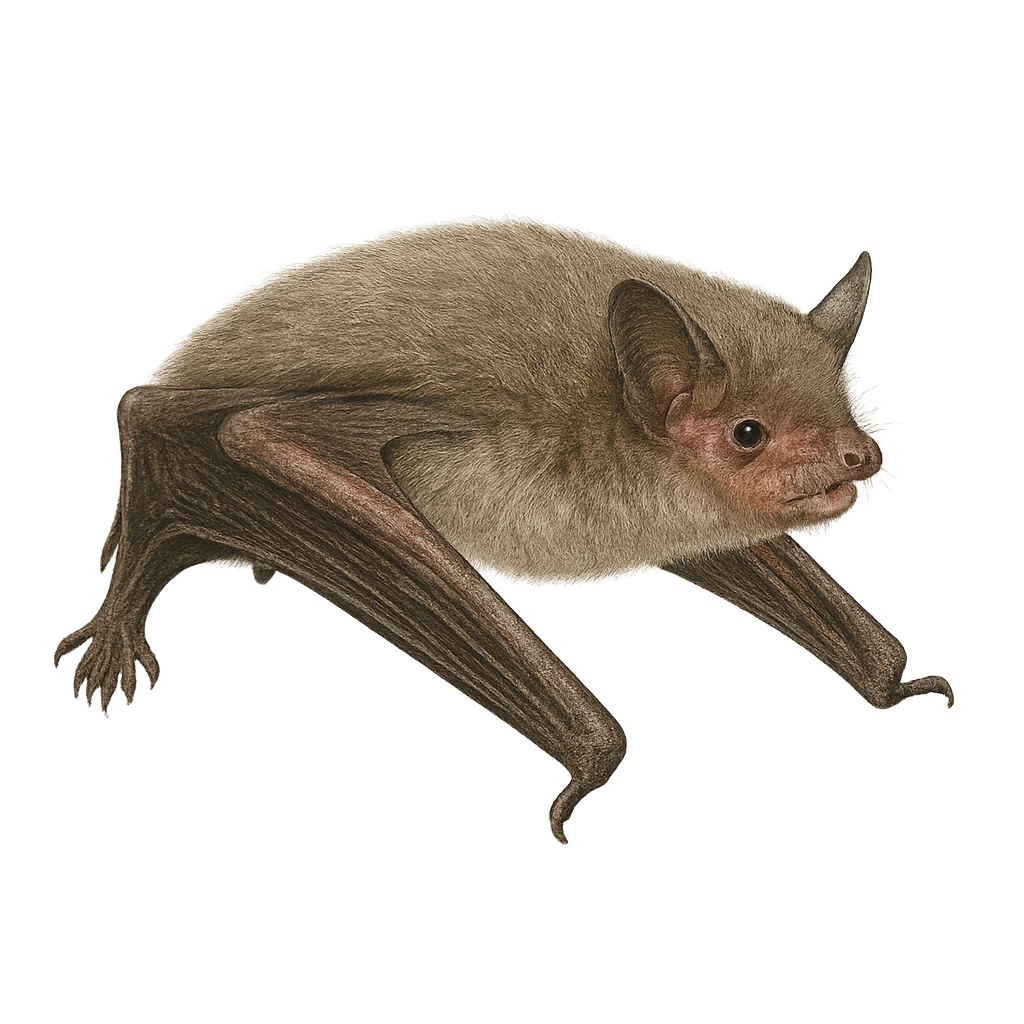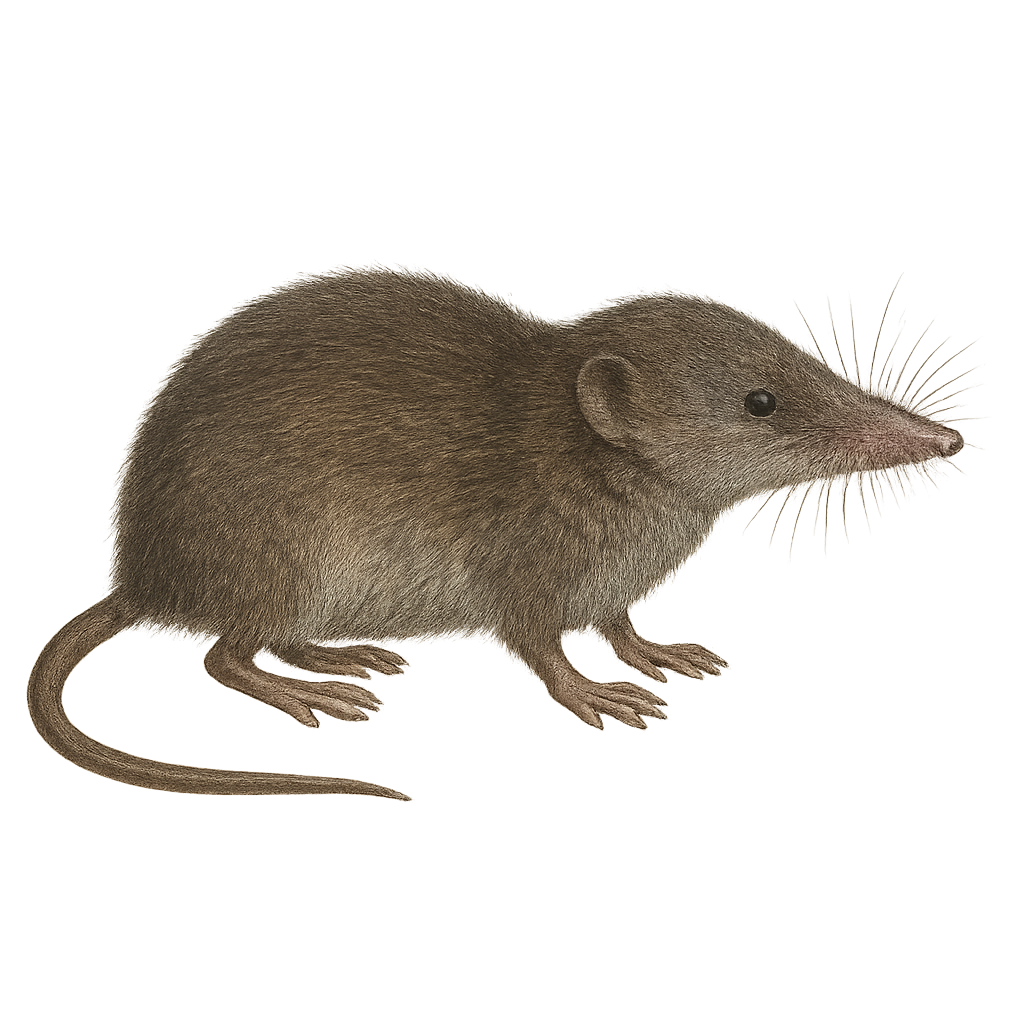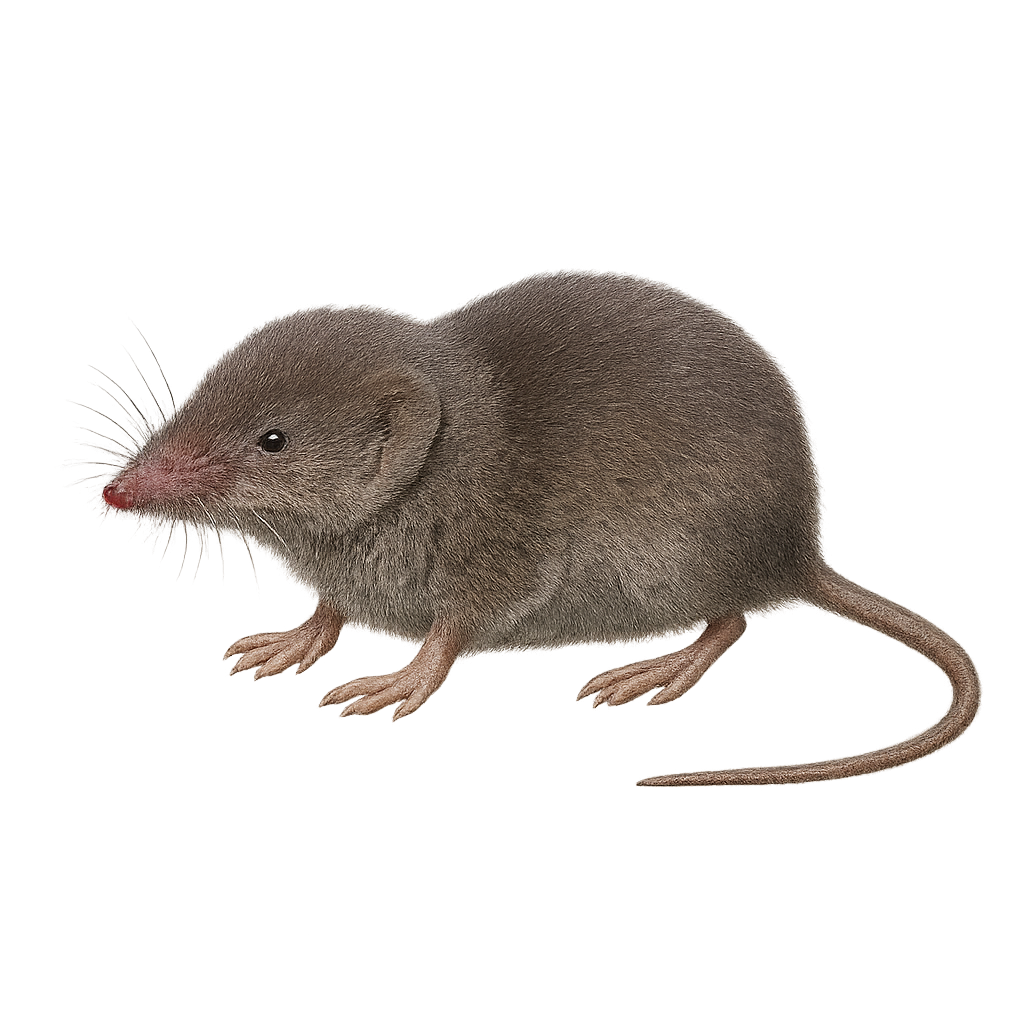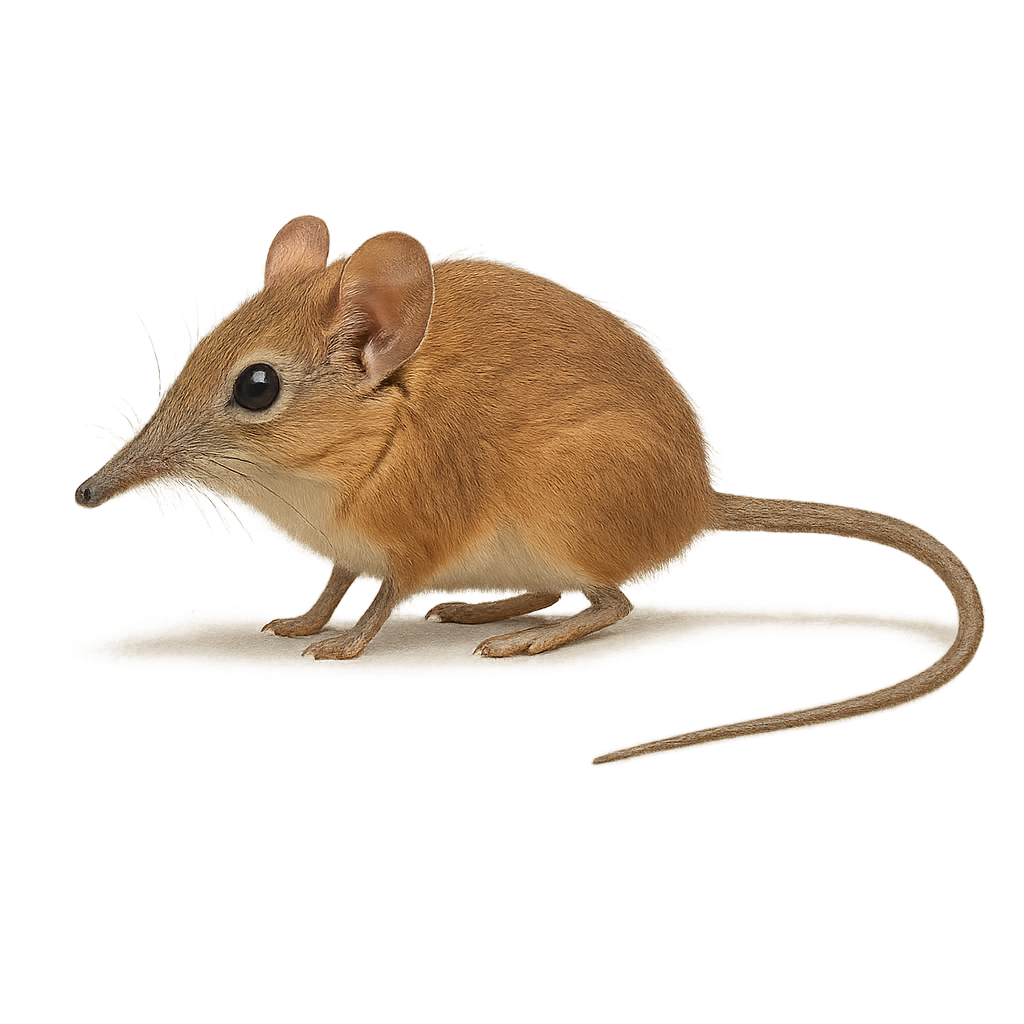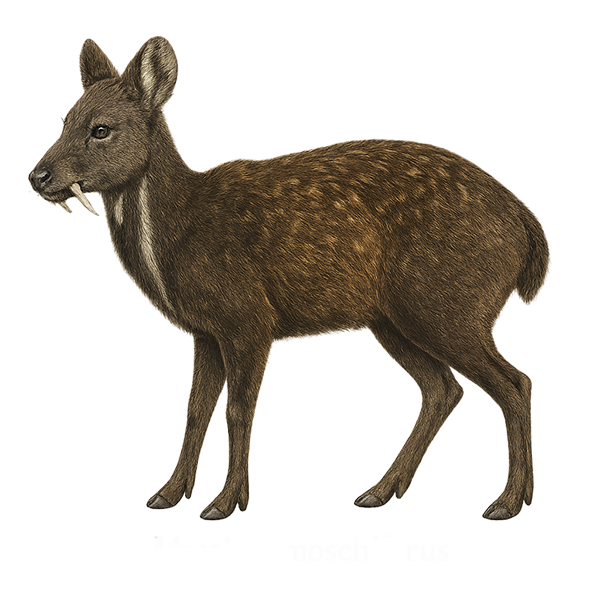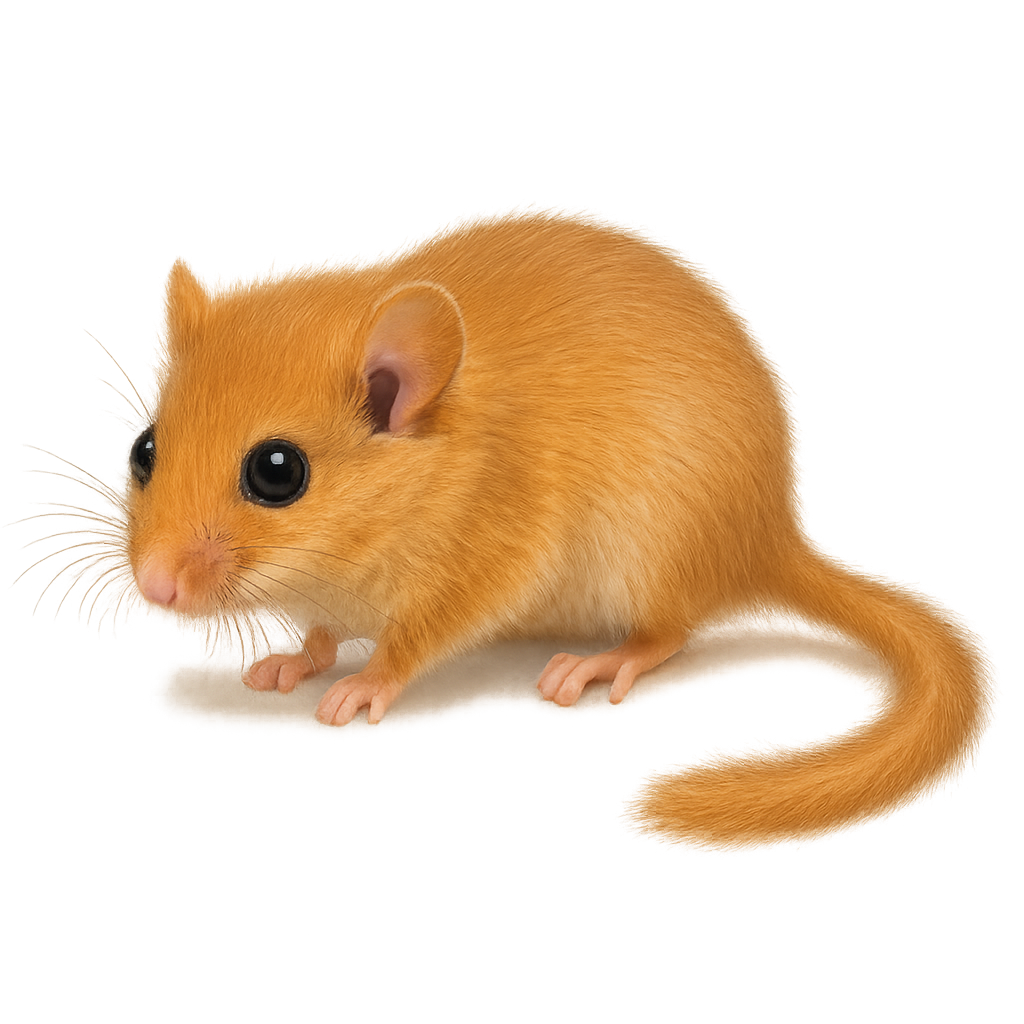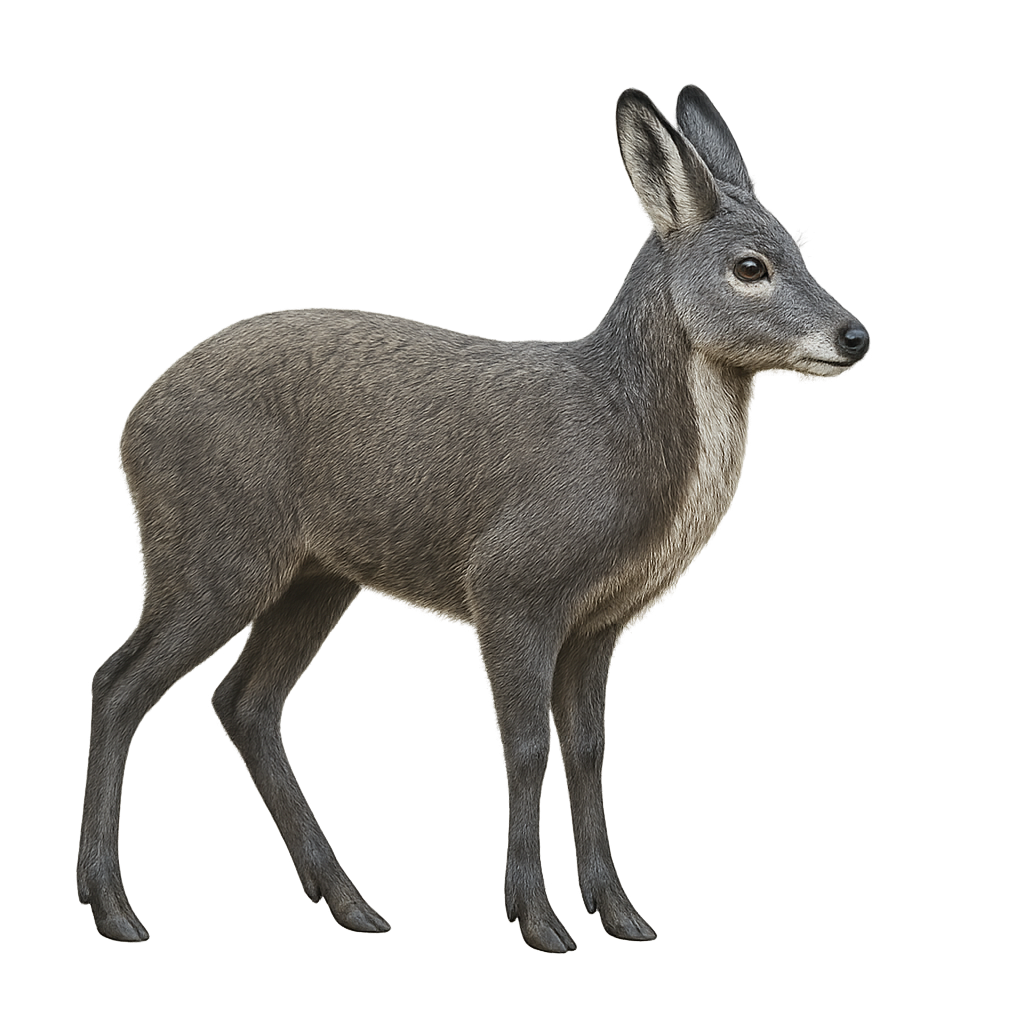The Indian Brown Mongoose, Herpestes fuscus, is a small carnivorous mammal native to the Indian subcontinent. It is characterized by its dark brown fur and slender body. Measuring about 50 to 60 cm in length, it has a bushy tail that accounts for nearly half of its total length. This species is primarily terrestrial and feeds on small animals, insects, and occasionally fruits. It is known for its ability to hunt snakes due to its agility and speed. The brown mongoose typically inhabits a variety of environments, from tropical forests to shrublands. Although often solitary, it can sometimes be seen in small family groups.
The Ruddy Mongoose, or Herpestes smithii, is a small carnivorous mammal native to the Indian subcontinent. It is characterized by its reddish-brown fur and bushy tail. Measuring about 50 to 60 cm in length, it weighs between 1.5 and 2.5 kg. Adapted to various habitats, it is often found in forests, grasslands, and agricultural areas. The Ruddy Mongoose is primarily diurnal and feeds on insects, small mammals, and reptiles. It is known for its ability to hunt snakes, thanks to its speed and agility. Although generally solitary, it can sometimes be seen in small family groups.
The Indian grey mongoose, Herpestes edwardsii, is a small carnivorous mammal native to the Indian subcontinent. It is recognizable by its grayish fur and bushy tail. Measuring between 36 and 45 cm, it typically weighs between 0.9 and 1.7 kg. Agile and fast, it is famous for its ability to hunt and kill venomous snakes, thanks to its speed and sharp reflexes. It inhabits various environments, from forests to agricultural areas, and adapts well to human-modified landscapes. The Indian grey mongoose is a diurnal animal, often seen foraging during the day.
The Slender mongoose is a small species of mongoose often found in the savannas and dry forests of East Africa. It primarily feeds on small insects, reptiles, and occasionally small mammals. With its slender body and quick movements, it is highly agile and often lives in family groups. Slender mongooses are very social and communicate with each other through vocalizations and visual signals. Although abundant, this species may be locally threatened by habitat loss.
The margay is a small arboreal wild cat species found from Mexico to northern Argentina. Solitary and nocturnal, it spends most of its time in trees, hunting birds, monkeys, and small mammals with exceptional climbing skills. It can rotate its ankles up to 180° to grasp branches and uses its long tail for balance. During the breeding season, the female emits a long moaning call to attract the male, which responds with trilling sounds and head shakes before mating high in the trees.
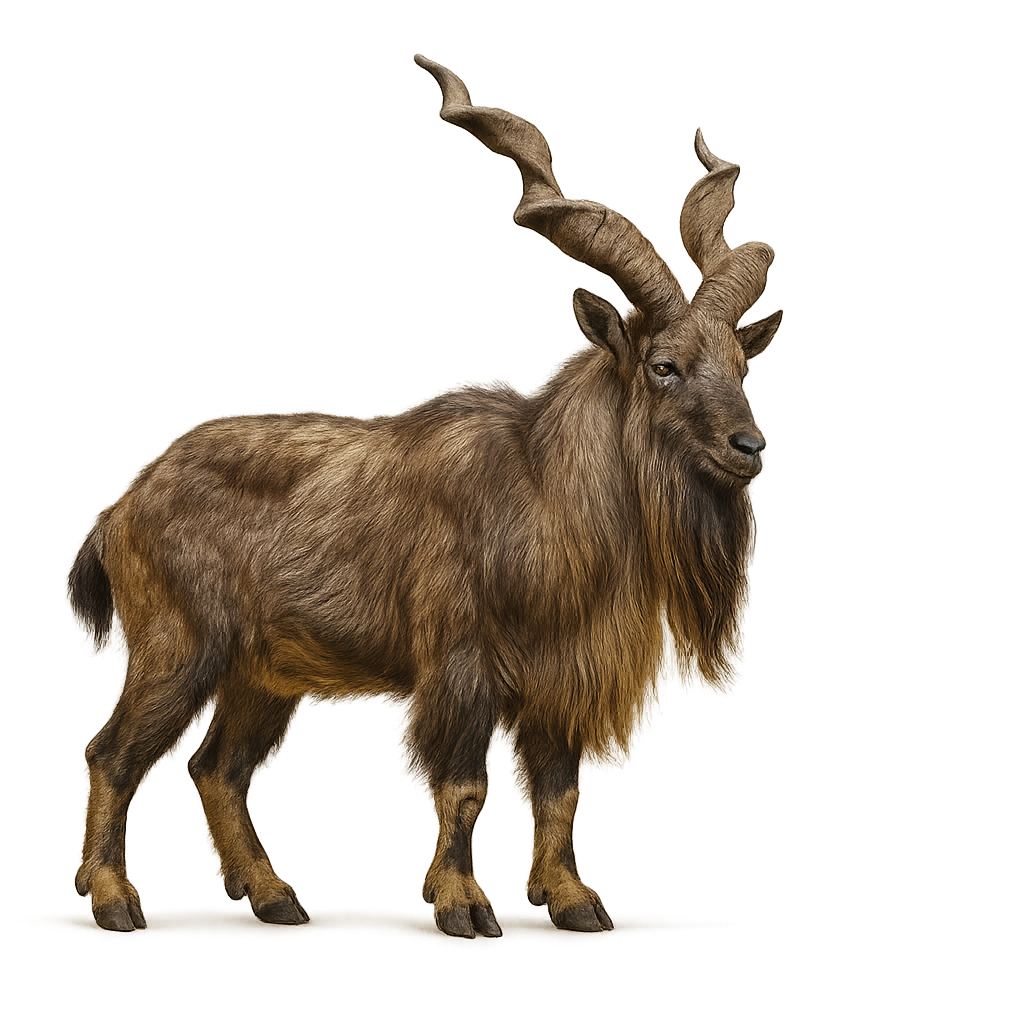
The Markhor is a wild goat species native to the mountains of Central Asia, primarily found in Afghanistan, Pakistan, Tajikistan, and India. It stands about 1.2 to 1.5 meters tall at the shoulder, with a body length of 1.5 to 2 meters, and weighs between 30 and 115 kg, with males generally being larger and more massive than females. The Markhor is famous for its impressive spiral horns, which can grow up to 1.5 meters long in adult males. Its coat is thick, typically brown or gray, with lighter fur on the belly and legs. It lives in mountainous and rocky areas, often at altitudes between 1,000 and 3,000 meters. The Markhor is an herbivore, feeding on mountain vegetation, including shrubs, leaves, and grasses. Although it is an agile climber and skilled at navigating steep terrain, it is also preyed upon by large predators such as snow leopards. The Markhor is classified as vulnerable due to overhunting, habitat loss, and human disturbances, but conservation efforts have helped stabilize its population in some areas.
The groundhog, also known as a woodchuck, is a medium-sized rodent belonging to the Sciuridae family. It is widely distributed across North America, particularly in grasslands, forests, and agricultural areas. With a stocky body and thick brown-gray fur, it measures about 40 to 65 cm in length, including the tail. Groundhogs are known for their hibernation behavior, spending the winter in deep burrows. They are primarily herbivorous, feeding on various plants, grasses, and occasionally insects. Although often solitary, they can be observed in small family groups. Their sharp alarm call is used to warn others of predators.
The Siberian marmot, Marmota sibirica, is a large rodent belonging to the Sciuridae family. It is primarily found in the steppes and grasslands of Mongolia, Russia, and northern China. This mammal is well adapted to cold climates, spending much of the year in hibernation. Its thick, dense fur ranges from brown to gray, providing excellent insulation against freezing temperatures. Siberian marmots live in colonies and dig extensive burrow systems to protect themselves from predators and harsh weather. They primarily feed on grasses, roots, and seeds. Although their population is stable, they are sometimes hunted for their fur and fat.
The Alpine Marmot is a large rodent primarily found in the mountainous regions of Europe, especially in the Alps, the Pyrenees, and the mountains of Italy. It measures about 40 to 60 cm in length, with a tail of 10 to 15 cm, and weighs between 3 and 7 kg, with females generally being a little smaller than males. Its coat is thick and typically brown-gray, with a lighter belly, allowing it to blend into its rocky and grassy environment. The Alpine Marmot lives in burrows dug into the ground, where it takes refuge to sleep, escape predators, and hibernate during the winter, a period when it enters a state of torpor for several months. During the summer season, it primarily feeds on grasses, roots, flowers, and berries. The Alpine Marmot is a social animal, typically living in family groups or colonies. While its population remains relatively stable, it is threatened by climate change and human development of its natural habitat.
The Common Porpoise is a small cetacean from the Phocoenidae family, found primarily in the temperate and cold waters of the North Atlantic and the North Sea, although its range also extends to certain parts of the Baltic Sea. It typically measures between 1.3 and 2 meters in length and weighs between 40 and 65 kg. Its coat is dark on the back and light on the belly, and it has a small dorsal fin located near the back. The Common Porpoise has a rounded snout and is easily recognizable by its small, rounded pectoral fins. It primarily feeds on fish, crustaceans, and cephalopods, hunting using echolocation to locate prey in the water. Although it is often seen in small groups, it generally prefers to swim alone or in small family units. While the species is classified as of least concern, it faces threats such as pollution, accidental bycatch in fishing nets, and disturbances caused by maritime traffic.
The Yellow-throated marten, Martes flavigula, is a mustelid with a distinctive yellow throat contrasting with its dark brown body. Agile and fast, it moves easily through the dense forests of Southeast Asia and the Himalayas. Omnivorous, it feeds on small mammals, birds, fruits, and insects. Its climbing ability and natural curiosity make it an effective predator. Although primarily terrestrial, it is also comfortable in trees. The yellow-throated marten is known for its relative sociability compared to other martens, often seen in small groups. It plays a crucial role in the ecosystem by regulating prey populations and dispersing seeds.
The European Marten is a small carnivorous mammal, measuring between 45 and 55 cm in length, with a tail of 25 to 30 cm. It typically weighs between 1.5 and 2 kg, with males being slightly larger than females. Its fur is reddish-brown on the back, with a lighter belly, sometimes pale yellow, and a distinctive white patch on the throat. The European Marten primarily inhabits forests, woodlands, and mountains across Europe, although it can also be found in agricultural areas and urban parks. It is an excellent climber and spends a lot of time in trees, where it primarily hunts birds, small mammals, insects, and fruits. The European Marten is a solitary, territorial animal, with nocturnal and crepuscular behavior. While its population remains relatively stable, it is threatened by habitat loss, hunting, and road collisions.
The Mona monkey, or Cercopithecus mona, is a medium-sized primate native to the tropical forests of West Africa. It is characterized by its golden-brown fur, white face, and long tail. Mona monkeys live in social groups and are known for their agility and ability to move quickly through the canopy. They primarily feed on fruits, but their diet also includes leaves, flowers, and insects. These monkeys are diurnal and spend most of their time foraging and socializing. Although generally wary of humans, they can become accustomed to their presence in protected areas.
The Eurasian elk, known as the largest member of the deer family, is found mainly in Scandinavia, Eastern Europe, and across Russia to parts of northern Asia. It can grow up to 2 meters tall at the shoulder and weigh between 350 and 600 kg. Males are known for their broad, palmate antlers, which can span up to 1.8 meters. Their coat is usually dark brown to black, with a lighter belly and a small mane under the neck. This herbivore feeds on leaves, twigs, bark, fruits, and aquatic plants. A strong swimmer, it often forages in wetlands, lakes, and damp forests. Although populations are stable in some areas, the species remains vulnerable due to habitat fragmentation and hunting.
The Pacific walrus, Odobenus rosmarus divergens, is an iconic species of the Arctic regions. With impressive tusks, it uses these long canines to haul itself onto ice and for defense. Its thick, wrinkled skin is covered with sparse hair, and it can weigh up to 1,700 kg. Males are generally larger than females. The walrus lives in large groups on ice floes and beaches, feeding mainly on mollusks found on the sea floor. Although an excellent swimmer, it spends much time resting on ice. Climate change and melting ice threaten its natural habitat, making its survival uncertain.
The striped skunk, or Mephitis mephitis, is a mammal renowned for its ability to spray a foul-smelling liquid when threatened. It features a black coat with two distinct white stripes running down its back. Primarily nocturnal, it feeds on insects, small mammals, fruits, and plants. It inhabits various environments, from forests to urban areas. Although often seen as a pest, it plays a crucial ecological role in controlling insect and rodent populations. The striped skunk is generally solitary, except during the breeding season.
The Barbary sheep, or Ammotragus lervia, is a robust caprid native to the mountains of North Africa. It is characterized by a mane of long hair that runs down its neck and forelegs. Its coat is typically tawny, allowing it to blend into the arid, rocky landscapes it inhabits. Adapted to desert environments, it can survive with minimal water, extracting necessary moisture from its food. Males have large, backward-curving horns used in dominance battles. The Barbary sheep lives in small groups and primarily feeds on grasses, leaves, and shrubs.
The Armenian Mouflon, Ovis orientalis gmelini, is a medium-sized mammal belonging to the Bovidae family. It is characterized by its spiral horns, more developed in males than in females. Its coat is generally brown with lighter shades on the belly and legs. This mouflon is mainly found in the mountainous regions of Armenia and Iran, where it adapts to rugged terrains and variable climatic conditions. It lives in herds, often separated by sex, and primarily feeds on grasses, herbs, and shrubs. The Armenian Mouflon plays an important ecological role as an herbivore, contributing to the regulation of vegetation in its natural habitat.
The bighorn sheep, or Ovis canadensis, is a mammal native to the mountainous regions of North America. Known for its large, spiraled horns, it primarily inhabits rocky terrains. Males, called rams, are particularly striking with horns that can weigh up to 30 pounds. Females, or ewes, have smaller, less curved horns. These animals live in herds and are well adapted to rugged landscapes thanks to their specialized hooves. Their coat ranges from light brown to gray, with a distinctive white patch on the rump. They primarily feed on grasses, plants, and shrubs.
The Corsican Mouflon is a subspecies of the Mouflon, native to the island of Corsica, where it primarily inhabits mountains and rocky areas. It measures about 70 cm in height at the withers and weighs between 40 and 70 kg. What distinguishes the Corsican Mouflon are its horns, which are particularly large and spirally curved in males, while females have smaller horns. Its coat is generally reddish-brown with lighter shades on the belly and a darker mane along the back. The Corsican Mouflon is an agile animal and an excellent climber, capable of moving easily through the steep and rocky terrain of its natural habitat. It feeds primarily on grasses, shrubs, leaves, and roots. While its population remains relatively stable on the island, it faces threats related to habitat loss and hunting. These animals are solitary or live in small groups, primarily during the breeding season.
The Asian mouflon, or Ovis orientalis, is a mammal from the Bovidae family, native to the mountains of Western Asia. It is recognizable by its large, spiraled horns, especially prominent in males. Its coat ranges from brown to gray, with lighter shades on the belly and legs. Mouflons live in herds, often segregated by sex, and navigate rugged, rocky terrains. They are herbivores, primarily feeding on grasses and low-growing plants. Their social behavior is complex, with established hierarchies within groups. Males compete during the rutting season to assert dominance and gain access to females.
The snow sheep, or Ovis nivicola, is a robust mammal primarily inhabiting the mountainous regions of the Russian Far East. It is characterized by its thick, woolly coat, which is well-suited to the harsh climatic conditions of its habitat. Males have large, spiraled horns, while females have smaller ones. Their diet mainly consists of grasses, lichens, and mosses. These animals are well adapted to high altitudes, where they find refuge on rocky and steep slopes. Their behavior is generally suspicious, making them difficult to approach. They live in small groups, often consisting of females and young, while adult males may be solitary or form separate groups.
The Mouflon oriental is a small wild sheep found primarily in the mountains of Europe, the Middle East, and Central Asia. It measures between 70 and 80 cm in height at the withers and weighs between 40 and 80 kg, with males generally being larger and more imposing than females. What distinguishes the Mouflon oriental is the presence of large, curved horns in males, while females have smaller and less pronounced horns. Their coat is generally reddish-brown in the summer, with a white belly and a darker mane along the back, which becomes thicker and fuller in the winter. The Mouflon oriental primarily inhabits mountainous areas, forests, and meadows, where it feeds on grasses, leaves, shrubs, and roots. It is an excellent climber and moves easily across rocky and steep terrain. While its population remains stable, the Mouflon oriental may be threatened by habitat loss, hunting, and competition with domesticated livestock.
The Daubenton's bat is a medium-sized bat, easily recognizable by its brown-grey fur on the back and lighter on the belly. Its ears are short and rounded, and its wings are long and narrow, adapted for fast and agile flight. This species is often seen flying low over water bodies, where it primarily hunts aquatic insects. It uses echolocation to navigate and locate its prey. The Daubenton's bat is a nocturnal animal, spending its days in shelters such as tree cavities, buildings, or bridges. It is widely distributed in Europe and Asia, preferring habitats near water.
The common shrew, or Sorex araneus, is a small insectivorous mammal found primarily in Europe. It measures about 5 to 8 cm in length, excluding its tail, which adds an additional 3 to 5 cm. Its fur is typically dark brown on the back and lighter on the belly, allowing it to blend into its natural surroundings. It has a pointed snout and characteristic red-tipped teeth. The common shrew is a very active animal, spending most of its time foraging for food, mainly insects, spiders, and worms. It has a very fast metabolism, meaning it needs to eat frequently to survive.
The crowned shrew, Sorex coronatus, is a small insectivorous mammal found mainly in Central Europe. It measures about 5 to 8 cm in length, with a tail of about 4 to 5 cm. Its fur is brown on the back and lighter on the belly. It is distinguished by its elongated head and pointed snout, typical of shrews. It inhabits various environments, including forests, meadows, and wetlands. It primarily feeds on insects, larvae, and small invertebrates. Although active year-round, it is particularly active at night. The crowned shrew plays an important role in the ecosystem by regulating insect populations.
Elephantulus rufescens is a small insectivorous mammal endemic to East Africa, measuring 10–15 cm with reddish fur and a distinctive elongated snout. It inhabits dry savannas, scrub, and forest edges, feeding on ants and small invertebrates using its long hind legs and sensitive muzzle.
The Siberian Musk Deer, scientifically known as Moschus moschiferus, is a small deer species notable for its lack of antlers and the presence of long canine teeth in males. These animals are primarily nocturnal and inhabit the coniferous forests and mountainous regions of Northern Asia, particularly in Russia, Mongolia, and China. Their thick, brown fur provides excellent camouflage in their natural habitat. Male musk deer produce a fragrant substance, musk, which has been used in perfumery for centuries. Although their population is declining due to hunting for musk and habitat loss, they remain a fascinating and iconic species of the Siberian forests.
The Common Dormouse is a small nocturnal rodent, often compared to a miniature squirrel, found mainly in forests, hedgerows, and gardens across Europe. It measures about 7 to 9 cm in length, with a tail of 5 to 7 cm, and weighs between 15 and 30 g. Its coat is typically brown or gray with a light belly, and it has large black eyes and round ears. The Common Dormouse is an arboreal and nocturnal animal that primarily feeds on fruits, seeds, nuts, and sometimes insects. It is an excellent climber, often living in trees or natural cavities. This small rodent is known for its hibernation behavior: it enters torpor during the winter months, retreating into its nest to survive the cold temperatures. Although it is widespread, it is threatened by habitat loss and human disturbances.
The forest musk deer, or Moschus berezovskii, is a small deer native to the mountainous forests of China and Vietnam. This mammal is particularly known for its musk gland, used in perfumery. It is characterized by its small size, long slender legs, and prominent canines in males. Its thick brown fur allows it to camouflage effectively in its natural habitat. Primarily nocturnal, it feeds on leaves, grasses, and lichens. Although discreet, it plays a crucial role in its ecosystem by participating in seed dispersal. Unfortunately, it is threatened by illegal hunting and habitat destruction, leading to a decline in its population.



